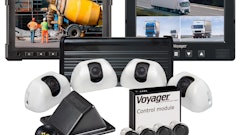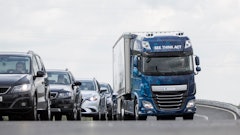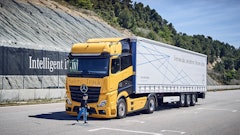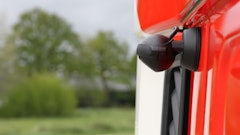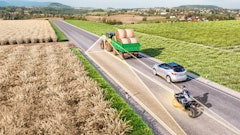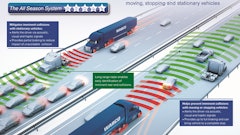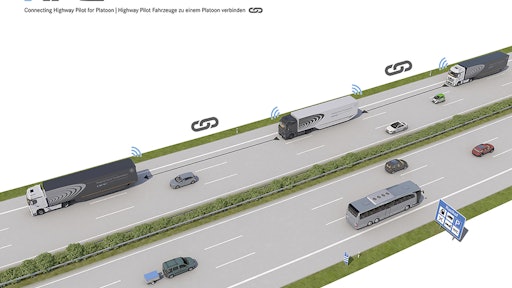
On April 6, six platoons of semi-automated trucks arrived at the Port of Rotterdam in the Netherlands as part of the European Truck Platooning Challenge. The project involved the vehicles traveling from various parts of Europe to demonstrate the benefits of truck platooning, the linking of two or more trucks in a convoy.
Similar in nature to other vehicle convoy, or leader-follower concepts already used in mining and military applications, truck platooning consists of the first vehicle dictating the speed and direction of travel which all other vehicles within the platoon follow.
The vehicles are wirelessly linked to one another through the use of various technologies including vehicle-to-vehicle communication systems and sensors. “Information about speed, acceleration, braking, position, etc. is shared between the vehicles so that a set distance between the trucks is maintained at all times the system is active,” explains Anders Kellström, Senior Product Planning Manager, Volvo Group.
Trucks within the platoon follow one another at a close distance, typically between 10 and 15 m (32.81 and 49.21 ft). “The close distance between the vehicles reduces drag, resulting in a substantial lowering of fuel consumption and emissions, on average by up to 7% for all vehicles in the platoon,” says Martin Zeilinger, Head of Advanced Engineering at Daimler Trucks.
Scania AB, one of the manufacturers taking part in the project, has been using platooning for its own transport operations for several years now, and has demonstrated fuel savings up to 10% in real traffic conditions due to the reduced drag capabilities of platooning.
Platooning is most beneficial during long haul highway applications because of the vehicles' travel speeds. Christoph Schuler, Connectivity/Automated Driving expert at MAN Truck & Bus, says optimal fuel savings, and subsequent reductions in carbon dioxide (CO2) emissions, are achieved at speeds above 80 km/h (49.71 mph) because the vehicles “can reach the highest slipstreaming effect [also known as drafting].” And the longer the vehicles travel in a platoon, the greater the fuel savings potential.
Safety improvements can be achieved, as well, by automating braking and other functions, eliminating the potential for human error. Kellström says follower trucks in the platoon can brake with virtually zero reaction time, improving both road use and safety.
Creating a truck platoon
DAF Trucks, Daimler, Iveco, MAN Truck & Bus, Scania and Volvo Group are the six OEMs who participated in the challenge. Cameras, sensors, radar and lidar are among the many technologies used by these companies to create the vehicle connectivity necessary for truck platooning.
Schuler says the trucks in the MAN platoon communicate via automotive Wi-Fi technology (IEEE 802.11P) which operates at a frequency of 5.9 GHz. This enables the trucks to be in constant contact with one another, transferring control commands and vehicle data such as braking deceleration and GPS position. “The parameters of the [vehicle-to-vehicle] communication are verified constantly with the values of the on-board sensor systems,” he says.
Daimler says the Wi-Fi technology enabled a network between the trucks within its platoon to be created by allowing the trucks’ onboard telematics systems to communicate with one another. The trucks were also able to take advantage of automated driving through the use of the Daimler’s Highway Pilot and Highway Pilot Connect longitudinal and lateral guidance systems. “The partially automated lateral guidance provided by Highway Pilot and Highway Pilot Connect…allows automated driving through active steering intervention which supports drivers,” says Zeilinger.
Highway Pilot Connect enables critical safety information, such as recognizing when emergency braking occurs, to be transferred rapidly, within 0.1 seconds, through the use of a radio processor and dual multiband high frequency transmitter/receiver.
The system utilizes a radar unit with two sensors located at the front of the truck to scan its surroundings and monitor speed of the vehicle directly ahead. The system’s long-range sensor has a range of 250 m (820.21 ft.) and covers an 18-degree segment while the short-range sensor has a range of 70 m (229.66 ft.) and scans a 130-degree area. Both sensors can measure speed with a precision of 0.1 km/h (0.06 mph) and distance to 20 cm (7.87 in.).
The sensors are connected to the system’s stereo camera to provide a complete picture of vehicle surroundings. The camera is located above the dashboard within the truck cab and scans the area ahead of the truck; it has a range of 100 m (328.08 ft.) and covers an area of 45 degrees horizontally and 27 degrees vertically. “The stereo camera identifies one- and two-lane roads, can precisely measure gaps and registers the information from road signs,” says Zeilinger.
Data from the sensors and camera are merged together within a sensor controller, enabling the system to recognize all moving and stationary objects in the truck’s vicinity and choose a suitable driving strategy.
Zeilinger says Daimler’s system also includes a high precision map so the truck is always aware of the road’s course and topography. The truck’s position is also determined based on information from the digital map and the combined data from the sensors and camera.
While the truck platoons developed by each of the companies have automation capabilities, it is still necessary to have a driver in each of the vehicles within the platoon. “The driver must permanently monitor the system and always be able to regain control of the vehicle,” explains Zeilinger. Each vehicle can join or leave the platoon at any time, further adding to the need to have a driver in each truck. “In addition to efficiency and safety aspects, the objective is to relieve the driver’s workload in monotonous driving situations, improve concentration and thereby ensure a higher level of safety in road traffic,” he explains.
Conditions of the Truck Platooning Challenge required the manufacturers to have platoons of no more than three vehicles. “Technically there is no limitation [on the number of vehicles in a platoon], but the limit is set by the surrounding traffic and safety considerations,” says Volvo’s Kellström. “One objective of the challenge was to learn about this by running on public roads.”
Both Schuler and Zeilinger say no more than 10 vehicles should be included in a platoon to ensure a stable connection between all vehicles at all times and to easily manage typical traffic conditions. “With longer platoons (five or more), the technical challenge will be the synchronous driving of all vehicles,” says Schuler. “An ‘accordion effect’ should be avoided, as it would have negative impacts on fuel efficiency.”
For a portion of its drive through Sweden—from Sodertalje to Malmo—Scania added an extra trailer to each of the truck and trailer combinations, creating total individual vehicle lengths of 32 m (104.99 ft.). “Longer vehicle combinations are something that we’re already testing on some stretches of road and with which we are achieving good results,” said Jonas Hofstedt, Head of Powertrain Development at Scania, in a press release regarding the company’s involvement in the platooning challenge. “Adding an extra trailer increases the amount of goods in every transport movement, reducing per tonne-kilometer costs by 40% and carbon dioxide emissions by more than one-quarter.”
What’s next?
Daimler, MAN and Volvo have been developing, testing and utilizing automation and vehicle connectivity technologies for several years, many of which were used within the platooning vehicles in combination with newer technologies such as vehicle-to-vehicle communication systems. “The system has been designed with sensors very close to serial production in order to promptly introduce platooning into mass production,” says Schuler.
He adds that today’s Wi-Fi standard has increased greatly from when MAN began its research into truck platooning in 2005, guaranteeing high stability and reliability of the systems used within the vehicles.
Each of the companies say they will continue advancing the technologies used in the truck platoons. Zeilinger says the high demands for data networking in the truck platooning vehicles creates a need for a stable and future-proof platform, which Daimler is working on. “We are working on the successive expansion towards a high level of automation based on high-performance sensors and data networking.” He says the company is also currently field testing its Highway Pilot system on Germany motorways.
According to Scania’s Hofstedt, “the European Truck Platooning Challenge is an excellent opportunity for us to increase awareness in both Sweden and Europe of the major advantages provided by vehicle convoys in achieving safer and more efficient transport operations and in improving traffic flows. We also hope to increase understanding of the fact that common standards are required for the different support systems, and that joint European legislation is required in order to enable large-scale convoy driving.”
In addition to Volvo’s continued development of automation technologies, Kellström says the company is involved with a platooning task force established by the European Automobile Manufacturers Association (ACEA)—which represents the 15 European-based car, van, truck and bus manufacturers—to define the next steps necessary to implement truck platooning in Europe.
He says further research is needed in the areas of safety, traffic behavior and human machine interface technology. “Also for platooning to be practical, [the ability to have] mixed brand platoons is important, and that requires development of communication standards.”
However, regulations are one of the biggest challenges associated with bringing truck platooning to the market. Currently, every country in Europe has different traffic regulations. Having harmonized regulations across all countries, however, would make it easier for truck platoon fleets to travel throughout the continent.
Melanie Schulz, the Dutch minister for Infrastructure and the Environment who spearheaded the Truck Platooning Challenge, said during a ceremony held upon the arrival of the six platoons in Rotterdam, “The results of this first ever major try-out in Europe are promising. The hands-on experience gained here will be very useful.... It will certainly help my colleagues and I discuss the adjustments needed to make self-driving transport a reality.”
Days after the completion of the European Truck Platooning Challenge, Europe’s transport minister, the European Commission and ACEA reached an agreement to work on the development and successful deployment of connected and automated driving technologies across Europe.
Erik Jonnaert, Secretary General of ACEA, stated at the site of the agreement, “Connected and automated driving is an important part of our response to future mobility challenges, in terms of balancing the growing demand for transport and mobility with environmental protection and increased safety. But even though this revolution is shaping our industry at a rapid pace, there are many challenges on the road ahead.”
Adapting traffic rules, improving digital infrastructure, establishing clear liability rules, securing personal data, promoting operational testing and increasing funding for research and development are all necessary to overcome these challenges.
Read more about the European Truck Platooning Challenge and the companies involved with the project.
Daimler Unveils Connected Trucks, Platooning Capabilities
Iveco Deploys Semi-Automated Trucks for World’s First Ever Truck Platooning Challenge
Volvo Participating in European Truck Platooning Challenge
Volvo's Truck Convoy Successfully Completes Journey Through Europe







